Analysis and Evaluation of IHG Plc Business and Financial Performance
VerifiedAdded on 2020/07/22
|51
|13657
|225
Report
AI Summary
This report provides a comprehensive analysis and evaluation of the business and financial performance of Intercontinental Hotel Plc (IHG Plc) over a three-year period. The study examines IHG Plc's financial performance by comparing it to its competitor, Millennium & Copthorne Hotels Plc. The research utilizes both primary and secondary data sources, including company websites, books, and scholarly articles, to assess key financial metrics, conduct ratio analysis, and evaluate the impact of economic factors on performance. The report delves into the hospitality industry's market share, the company's overview, and employs an inductive research approach. It addresses research questions related to IHG Plc's competitiveness, key value drivers, the impact of economic recession, and strategic positioning. The findings include financial performance evaluations, business analysis, conclusions, and recommendations, supported by references and appendices containing financial statements and ratio analyses. The report aims to determine effective performance drivers and organizational barriers, and to offer recommendations based on financial performance analysis.
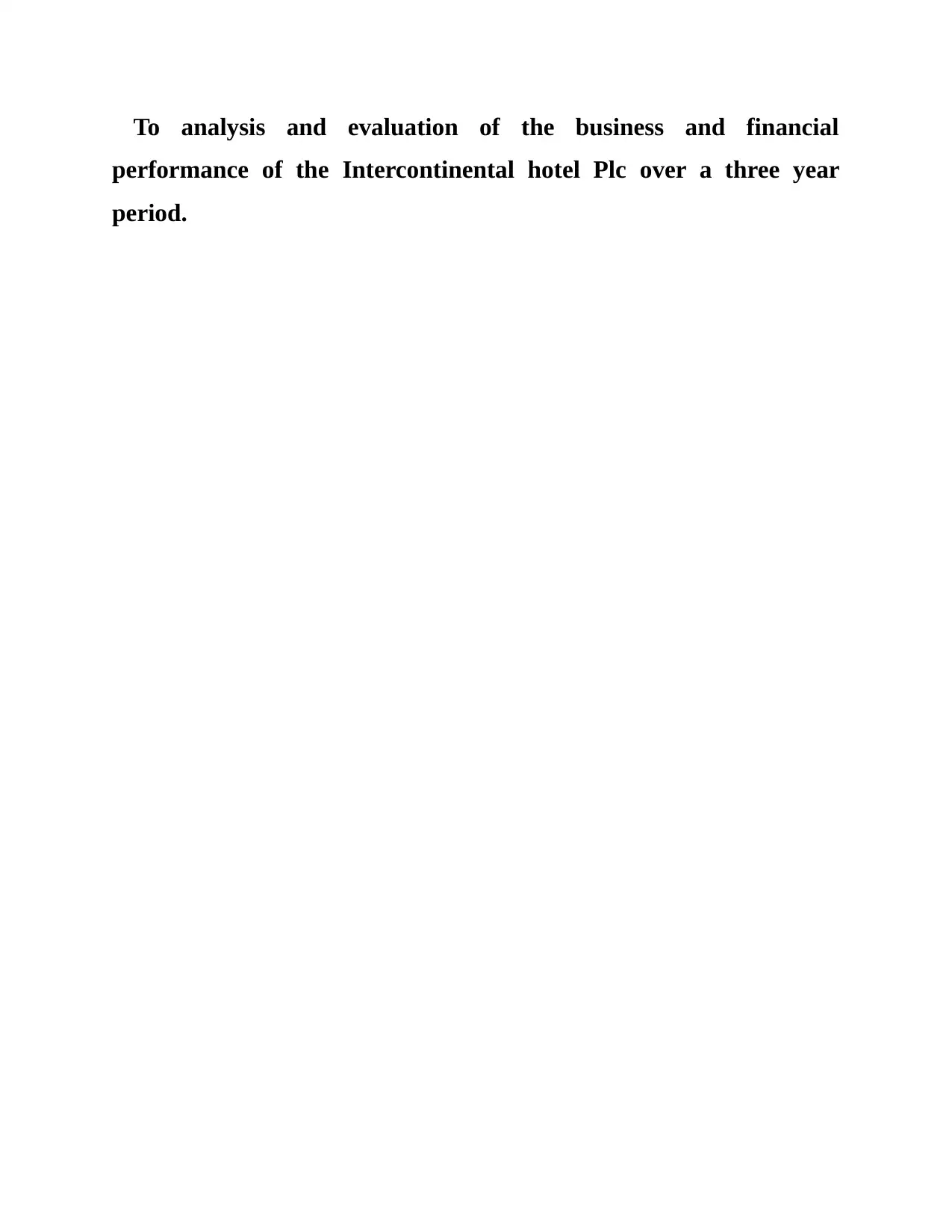
To analysis and evaluation of the business and financial
performance of the Intercontinental hotel Plc over a three year
period.
performance of the Intercontinental hotel Plc over a three year
period.
Paraphrase This Document
Need a fresh take? Get an instant paraphrase of this document with our AI Paraphraser
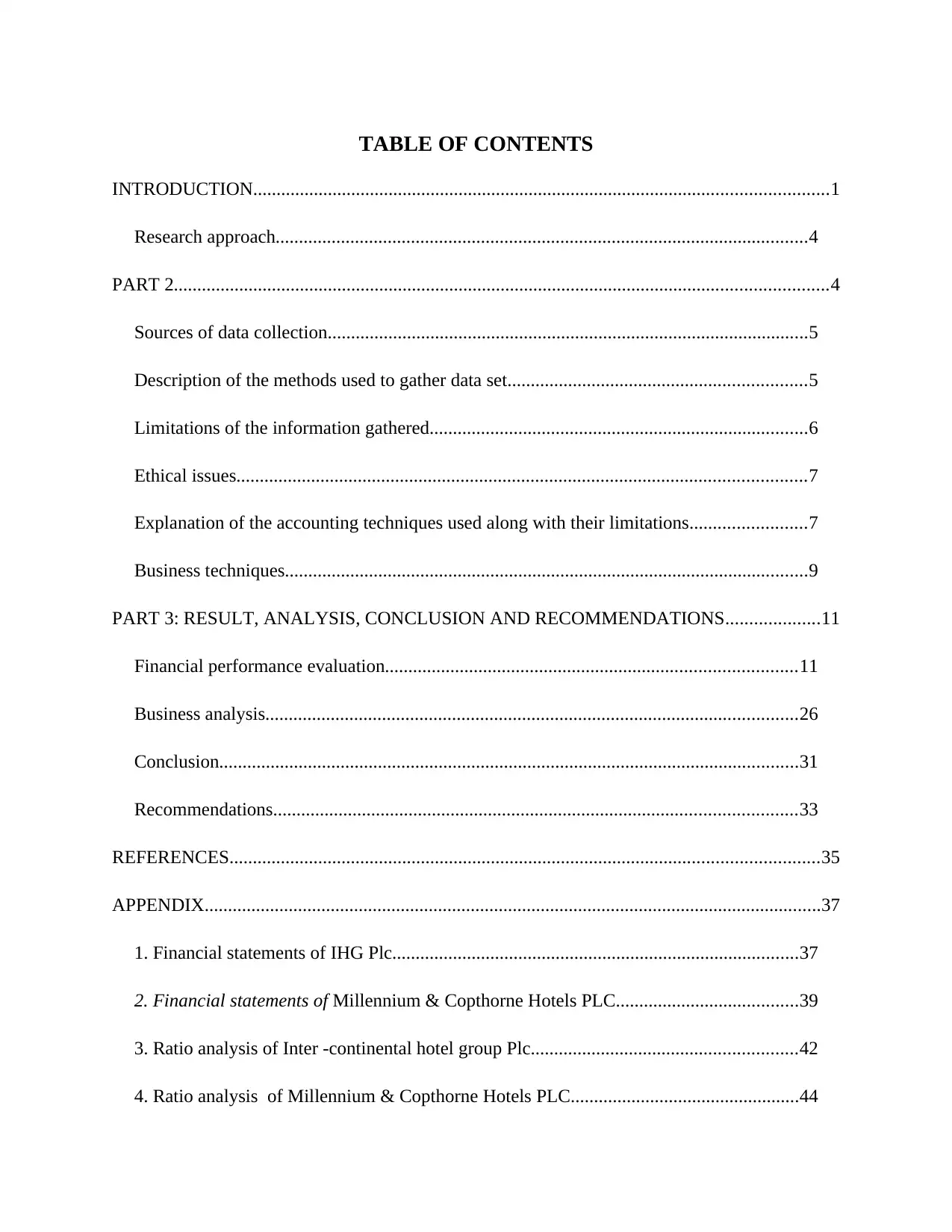
TABLE OF CONTENTS
INTRODUCTION...........................................................................................................................1
Research approach..................................................................................................................4
PART 2............................................................................................................................................4
Sources of data collection.......................................................................................................5
Description of the methods used to gather data set................................................................5
Limitations of the information gathered.................................................................................6
Ethical issues..........................................................................................................................7
Explanation of the accounting techniques used along with their limitations.........................7
Business techniques................................................................................................................9
PART 3: RESULT, ANALYSIS, CONCLUSION AND RECOMMENDATIONS....................11
Financial performance evaluation........................................................................................11
Business analysis..................................................................................................................26
Conclusion............................................................................................................................31
Recommendations................................................................................................................33
REFERENCES..............................................................................................................................35
APPENDIX....................................................................................................................................37
1. Financial statements of IHG Plc.......................................................................................37
2. Financial statements of Millennium & Copthorne Hotels PLC.......................................39
3. Ratio analysis of Inter -continental hotel group Plc.........................................................42
4. Ratio analysis of Millennium & Copthorne Hotels PLC.................................................44
INTRODUCTION...........................................................................................................................1
Research approach..................................................................................................................4
PART 2............................................................................................................................................4
Sources of data collection.......................................................................................................5
Description of the methods used to gather data set................................................................5
Limitations of the information gathered.................................................................................6
Ethical issues..........................................................................................................................7
Explanation of the accounting techniques used along with their limitations.........................7
Business techniques................................................................................................................9
PART 3: RESULT, ANALYSIS, CONCLUSION AND RECOMMENDATIONS....................11
Financial performance evaluation........................................................................................11
Business analysis..................................................................................................................26
Conclusion............................................................................................................................31
Recommendations................................................................................................................33
REFERENCES..............................................................................................................................35
APPENDIX....................................................................................................................................37
1. Financial statements of IHG Plc.......................................................................................37
2. Financial statements of Millennium & Copthorne Hotels PLC.......................................39
3. Ratio analysis of Inter -continental hotel group Plc.........................................................42
4. Ratio analysis of Millennium & Copthorne Hotels PLC.................................................44

⊘ This is a preview!⊘
Do you want full access?
Subscribe today to unlock all pages.

Trusted by 1+ million students worldwide
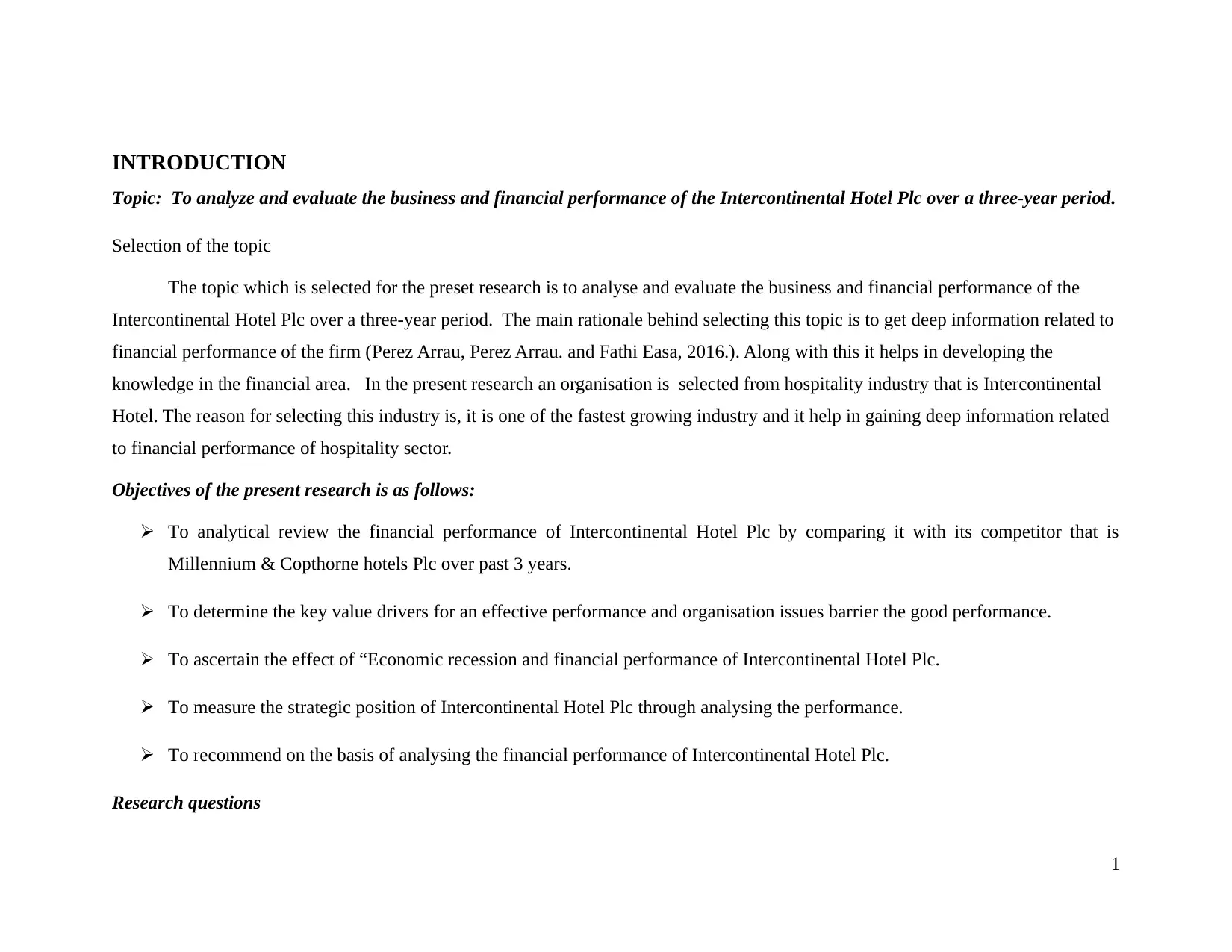
INTRODUCTION
Topic: To analyze and evaluate the business and financial performance of the Intercontinental Hotel Plc over a three-year period.
Selection of the topic
The topic which is selected for the preset research is to analyse and evaluate the business and financial performance of the
Intercontinental Hotel Plc over a three-year period. The main rationale behind selecting this topic is to get deep information related to
financial performance of the firm (Perez Arrau, Perez Arrau. and Fathi Easa, 2016.). Along with this it helps in developing the
knowledge in the financial area. In the present research an organisation is selected from hospitality industry that is Intercontinental
Hotel. The reason for selecting this industry is, it is one of the fastest growing industry and it help in gaining deep information related
to financial performance of hospitality sector.
Objectives of the present research is as follows:
To analytical review the financial performance of Intercontinental Hotel Plc by comparing it with its competitor that is
Millennium & Copthorne hotels Plc over past 3 years.
To determine the key value drivers for an effective performance and organisation issues barrier the good performance.
To ascertain the effect of “Economic recession and financial performance of Intercontinental Hotel Plc.
To measure the strategic position of Intercontinental Hotel Plc through analysing the performance.
To recommend on the basis of analysing the financial performance of Intercontinental Hotel Plc.
Research questions
1
Topic: To analyze and evaluate the business and financial performance of the Intercontinental Hotel Plc over a three-year period.
Selection of the topic
The topic which is selected for the preset research is to analyse and evaluate the business and financial performance of the
Intercontinental Hotel Plc over a three-year period. The main rationale behind selecting this topic is to get deep information related to
financial performance of the firm (Perez Arrau, Perez Arrau. and Fathi Easa, 2016.). Along with this it helps in developing the
knowledge in the financial area. In the present research an organisation is selected from hospitality industry that is Intercontinental
Hotel. The reason for selecting this industry is, it is one of the fastest growing industry and it help in gaining deep information related
to financial performance of hospitality sector.
Objectives of the present research is as follows:
To analytical review the financial performance of Intercontinental Hotel Plc by comparing it with its competitor that is
Millennium & Copthorne hotels Plc over past 3 years.
To determine the key value drivers for an effective performance and organisation issues barrier the good performance.
To ascertain the effect of “Economic recession and financial performance of Intercontinental Hotel Plc.
To measure the strategic position of Intercontinental Hotel Plc through analysing the performance.
To recommend on the basis of analysing the financial performance of Intercontinental Hotel Plc.
Research questions
1
Paraphrase This Document
Need a fresh take? Get an instant paraphrase of this document with our AI Paraphraser
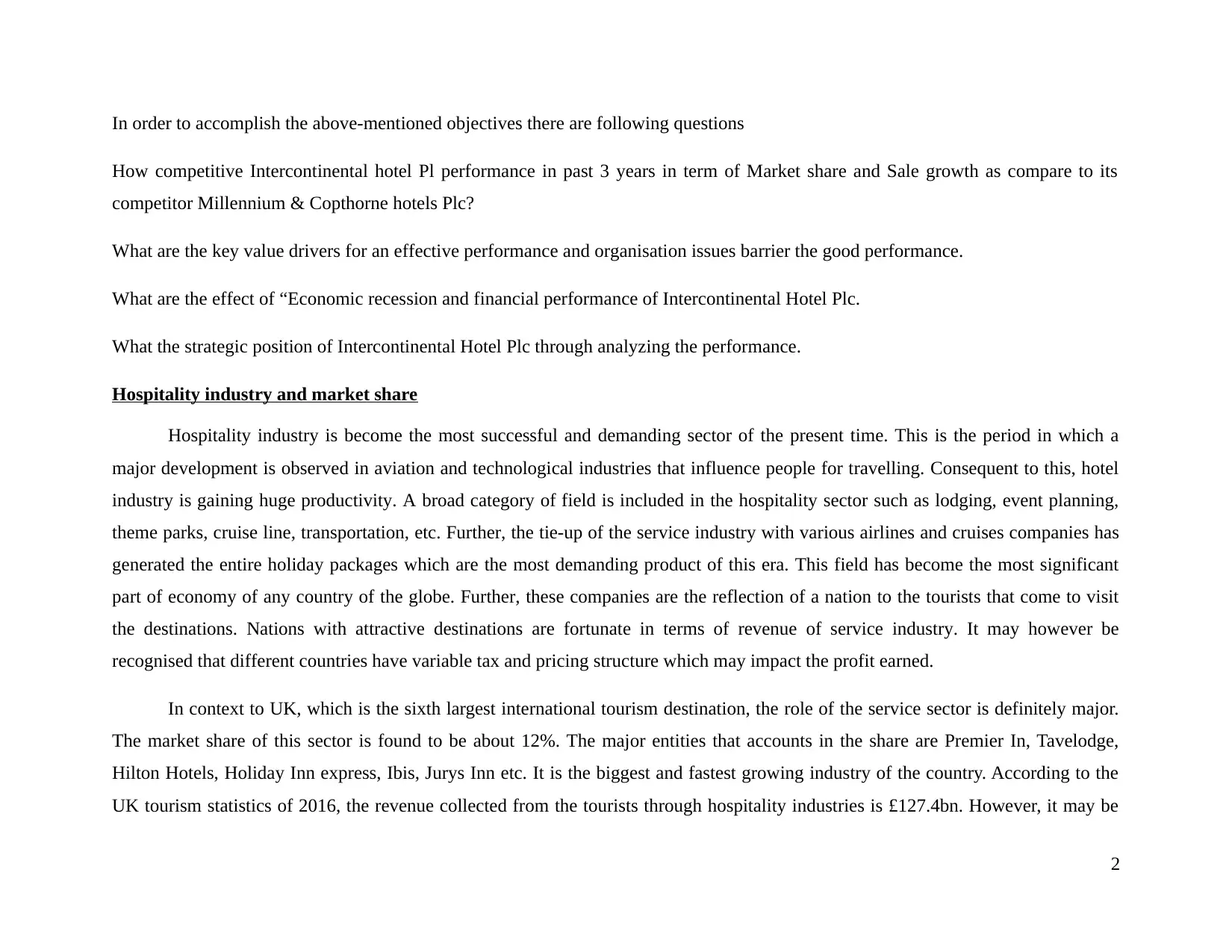
In order to accomplish the above-mentioned objectives there are following questions
How competitive Intercontinental hotel Pl performance in past 3 years in term of Market share and Sale growth as compare to its
competitor Millennium & Copthorne hotels Plc?
What are the key value drivers for an effective performance and organisation issues barrier the good performance.
What are the effect of “Economic recession and financial performance of Intercontinental Hotel Plc.
What the strategic position of Intercontinental Hotel Plc through analyzing the performance.
Hospitality industry and market share
Hospitality industry is become the most successful and demanding sector of the present time. This is the period in which a
major development is observed in aviation and technological industries that influence people for travelling. Consequent to this, hotel
industry is gaining huge productivity. A broad category of field is included in the hospitality sector such as lodging, event planning,
theme parks, cruise line, transportation, etc. Further, the tie-up of the service industry with various airlines and cruises companies has
generated the entire holiday packages which are the most demanding product of this era. This field has become the most significant
part of economy of any country of the globe. Further, these companies are the reflection of a nation to the tourists that come to visit
the destinations. Nations with attractive destinations are fortunate in terms of revenue of service industry. It may however be
recognised that different countries have variable tax and pricing structure which may impact the profit earned.
In context to UK, which is the sixth largest international tourism destination, the role of the service sector is definitely major.
The market share of this sector is found to be about 12%. The major entities that accounts in the share are Premier In, Tavelodge,
Hilton Hotels, Holiday Inn express, Ibis, Jurys Inn etc. It is the biggest and fastest growing industry of the country. According to the
UK tourism statistics of 2016, the revenue collected from the tourists through hospitality industries is £127.4bn. However, it may be
2
How competitive Intercontinental hotel Pl performance in past 3 years in term of Market share and Sale growth as compare to its
competitor Millennium & Copthorne hotels Plc?
What are the key value drivers for an effective performance and organisation issues barrier the good performance.
What are the effect of “Economic recession and financial performance of Intercontinental Hotel Plc.
What the strategic position of Intercontinental Hotel Plc through analyzing the performance.
Hospitality industry and market share
Hospitality industry is become the most successful and demanding sector of the present time. This is the period in which a
major development is observed in aviation and technological industries that influence people for travelling. Consequent to this, hotel
industry is gaining huge productivity. A broad category of field is included in the hospitality sector such as lodging, event planning,
theme parks, cruise line, transportation, etc. Further, the tie-up of the service industry with various airlines and cruises companies has
generated the entire holiday packages which are the most demanding product of this era. This field has become the most significant
part of economy of any country of the globe. Further, these companies are the reflection of a nation to the tourists that come to visit
the destinations. Nations with attractive destinations are fortunate in terms of revenue of service industry. It may however be
recognised that different countries have variable tax and pricing structure which may impact the profit earned.
In context to UK, which is the sixth largest international tourism destination, the role of the service sector is definitely major.
The market share of this sector is found to be about 12%. The major entities that accounts in the share are Premier In, Tavelodge,
Hilton Hotels, Holiday Inn express, Ibis, Jurys Inn etc. It is the biggest and fastest growing industry of the country. According to the
UK tourism statistics of 2016, the revenue collected from the tourists through hospitality industries is £127.4bn. However, it may be
2
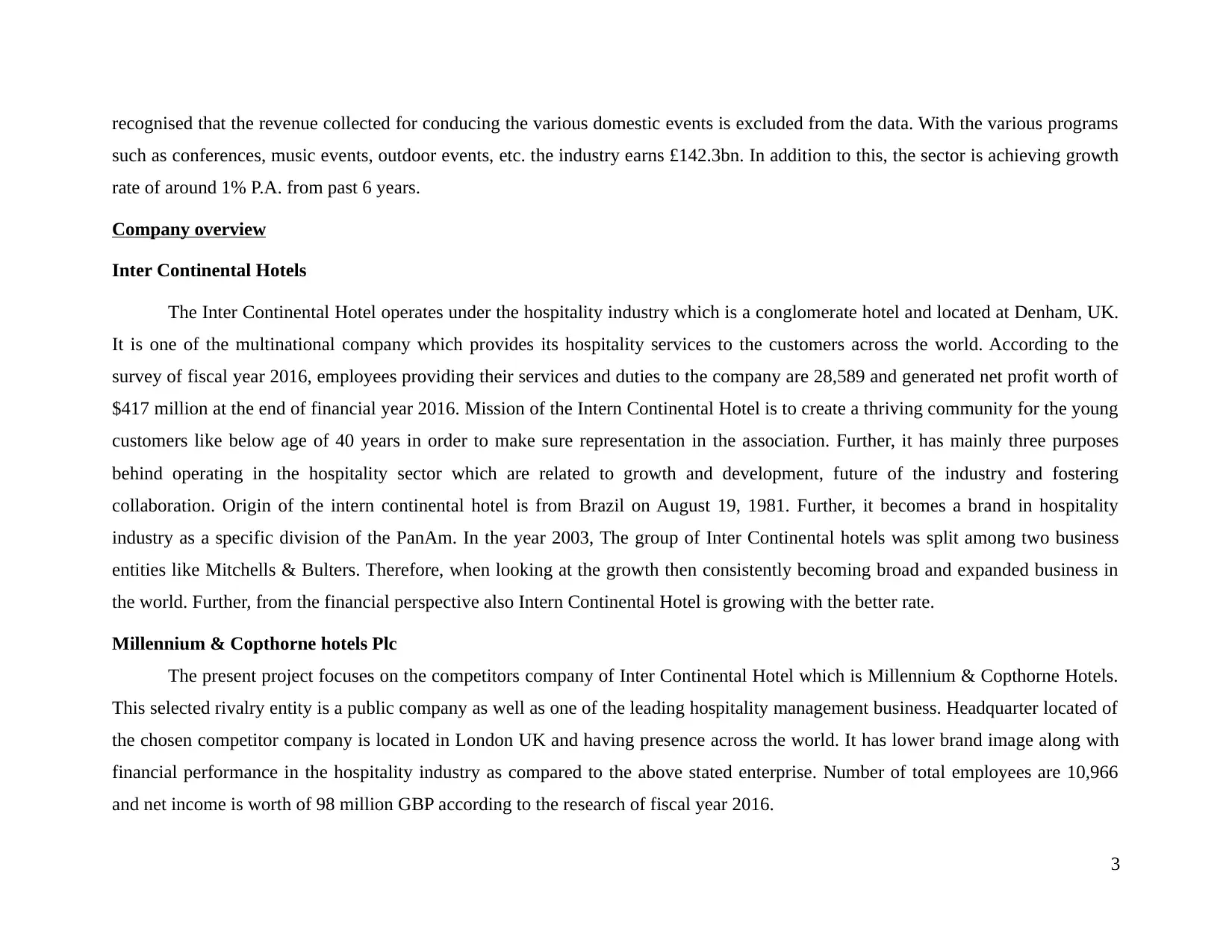
recognised that the revenue collected for conducing the various domestic events is excluded from the data. With the various programs
such as conferences, music events, outdoor events, etc. the industry earns £142.3bn. In addition to this, the sector is achieving growth
rate of around 1% P.A. from past 6 years.
Company overview
Inter Continental Hotels
The Inter Continental Hotel operates under the hospitality industry which is a conglomerate hotel and located at Denham, UK.
It is one of the multinational company which provides its hospitality services to the customers across the world. According to the
survey of fiscal year 2016, employees providing their services and duties to the company are 28,589 and generated net profit worth of
$417 million at the end of financial year 2016. Mission of the Intern Continental Hotel is to create a thriving community for the young
customers like below age of 40 years in order to make sure representation in the association. Further, it has mainly three purposes
behind operating in the hospitality sector which are related to growth and development, future of the industry and fostering
collaboration. Origin of the intern continental hotel is from Brazil on August 19, 1981. Further, it becomes a brand in hospitality
industry as a specific division of the PanAm. In the year 2003, The group of Inter Continental hotels was split among two business
entities like Mitchells & Bulters. Therefore, when looking at the growth then consistently becoming broad and expanded business in
the world. Further, from the financial perspective also Intern Continental Hotel is growing with the better rate.
Millennium & Copthorne hotels Plc
The present project focuses on the competitors company of Inter Continental Hotel which is Millennium & Copthorne Hotels.
This selected rivalry entity is a public company as well as one of the leading hospitality management business. Headquarter located of
the chosen competitor company is located in London UK and having presence across the world. It has lower brand image along with
financial performance in the hospitality industry as compared to the above stated enterprise. Number of total employees are 10,966
and net income is worth of 98 million GBP according to the research of fiscal year 2016.
3
such as conferences, music events, outdoor events, etc. the industry earns £142.3bn. In addition to this, the sector is achieving growth
rate of around 1% P.A. from past 6 years.
Company overview
Inter Continental Hotels
The Inter Continental Hotel operates under the hospitality industry which is a conglomerate hotel and located at Denham, UK.
It is one of the multinational company which provides its hospitality services to the customers across the world. According to the
survey of fiscal year 2016, employees providing their services and duties to the company are 28,589 and generated net profit worth of
$417 million at the end of financial year 2016. Mission of the Intern Continental Hotel is to create a thriving community for the young
customers like below age of 40 years in order to make sure representation in the association. Further, it has mainly three purposes
behind operating in the hospitality sector which are related to growth and development, future of the industry and fostering
collaboration. Origin of the intern continental hotel is from Brazil on August 19, 1981. Further, it becomes a brand in hospitality
industry as a specific division of the PanAm. In the year 2003, The group of Inter Continental hotels was split among two business
entities like Mitchells & Bulters. Therefore, when looking at the growth then consistently becoming broad and expanded business in
the world. Further, from the financial perspective also Intern Continental Hotel is growing with the better rate.
Millennium & Copthorne hotels Plc
The present project focuses on the competitors company of Inter Continental Hotel which is Millennium & Copthorne Hotels.
This selected rivalry entity is a public company as well as one of the leading hospitality management business. Headquarter located of
the chosen competitor company is located in London UK and having presence across the world. It has lower brand image along with
financial performance in the hospitality industry as compared to the above stated enterprise. Number of total employees are 10,966
and net income is worth of 98 million GBP according to the research of fiscal year 2016.
3
⊘ This is a preview!⊘
Do you want full access?
Subscribe today to unlock all pages.

Trusted by 1+ million students worldwide
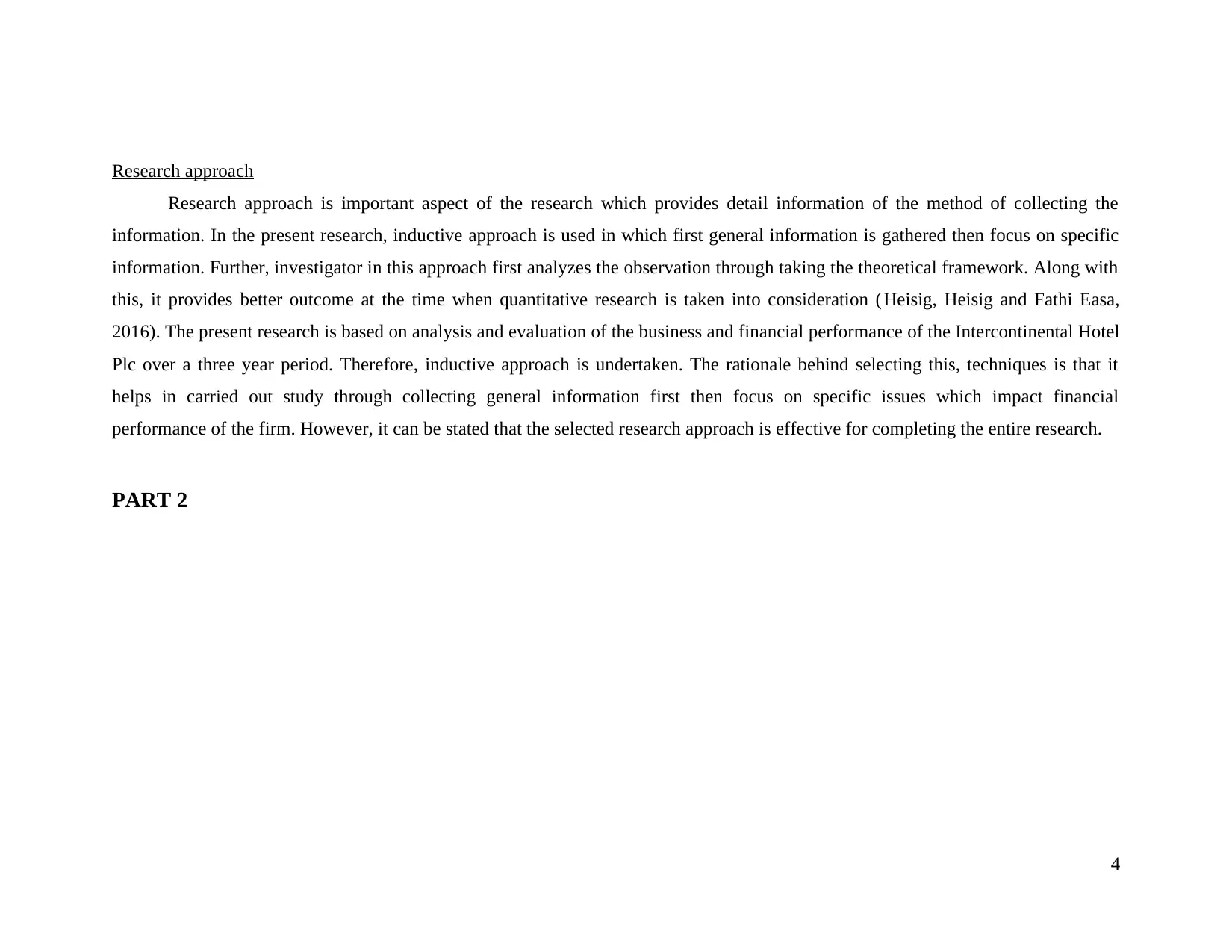
Research approach
Research approach is important aspect of the research which provides detail information of the method of collecting the
information. In the present research, inductive approach is used in which first general information is gathered then focus on specific
information. Further, investigator in this approach first analyzes the observation through taking the theoretical framework. Along with
this, it provides better outcome at the time when quantitative research is taken into consideration ( Heisig, Heisig and Fathi Easa,
2016). The present research is based on analysis and evaluation of the business and financial performance of the Intercontinental Hotel
Plc over a three year period. Therefore, inductive approach is undertaken. The rationale behind selecting this, techniques is that it
helps in carried out study through collecting general information first then focus on specific issues which impact financial
performance of the firm. However, it can be stated that the selected research approach is effective for completing the entire research.
PART 2
4
Research approach is important aspect of the research which provides detail information of the method of collecting the
information. In the present research, inductive approach is used in which first general information is gathered then focus on specific
information. Further, investigator in this approach first analyzes the observation through taking the theoretical framework. Along with
this, it provides better outcome at the time when quantitative research is taken into consideration ( Heisig, Heisig and Fathi Easa,
2016). The present research is based on analysis and evaluation of the business and financial performance of the Intercontinental Hotel
Plc over a three year period. Therefore, inductive approach is undertaken. The rationale behind selecting this, techniques is that it
helps in carried out study through collecting general information first then focus on specific issues which impact financial
performance of the firm. However, it can be stated that the selected research approach is effective for completing the entire research.
PART 2
4
Paraphrase This Document
Need a fresh take? Get an instant paraphrase of this document with our AI Paraphraser
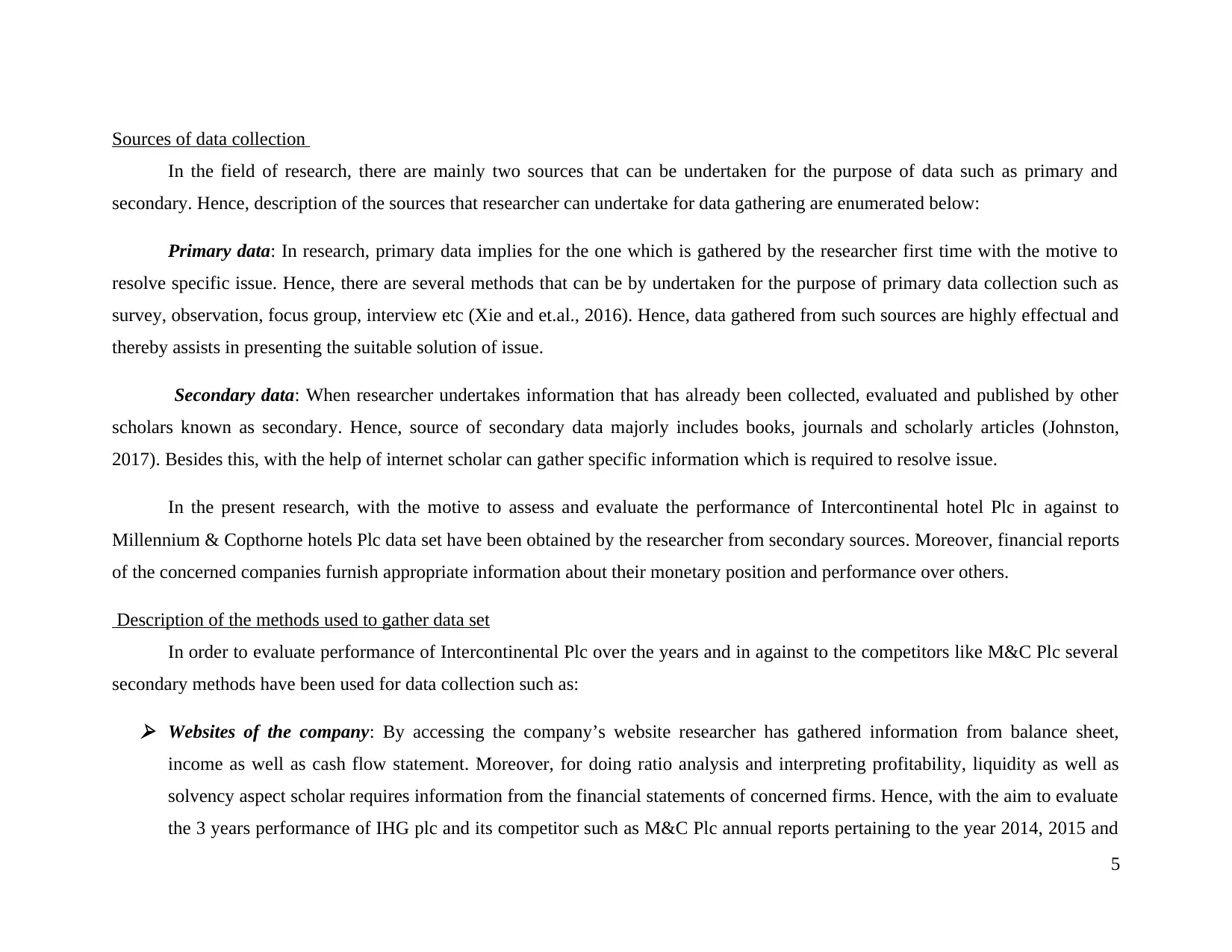
Sources of data collection
In the field of research, there are mainly two sources that can be undertaken for the purpose of data such as primary and
secondary. Hence, description of the sources that researcher can undertake for data gathering are enumerated below:
Primary data: In research, primary data implies for the one which is gathered by the researcher first time with the motive to
resolve specific issue. Hence, there are several methods that can be by undertaken for the purpose of primary data collection such as
survey, observation, focus group, interview etc (Xie and et.al., 2016). Hence, data gathered from such sources are highly effectual and
thereby assists in presenting the suitable solution of issue.
Secondary data: When researcher undertakes information that has already been collected, evaluated and published by other
scholars known as secondary. Hence, source of secondary data majorly includes books, journals and scholarly articles (Johnston,
2017). Besides this, with the help of internet scholar can gather specific information which is required to resolve issue.
In the present research, with the motive to assess and evaluate the performance of Intercontinental hotel Plc in against to
Millennium & Copthorne hotels Plc data set have been obtained by the researcher from secondary sources. Moreover, financial reports
of the concerned companies furnish appropriate information about their monetary position and performance over others.
Description of the methods used to gather data set
In order to evaluate performance of Intercontinental Plc over the years and in against to the competitors like M&C Plc several
secondary methods have been used for data collection such as:
Websites of the company: By accessing the company’s website researcher has gathered information from balance sheet,
income as well as cash flow statement. Moreover, for doing ratio analysis and interpreting profitability, liquidity as well as
solvency aspect scholar requires information from the financial statements of concerned firms. Hence, with the aim to evaluate
the 3 years performance of IHG plc and its competitor such as M&C Plc annual reports pertaining to the year 2014, 2015 and
5
In the field of research, there are mainly two sources that can be undertaken for the purpose of data such as primary and
secondary. Hence, description of the sources that researcher can undertake for data gathering are enumerated below:
Primary data: In research, primary data implies for the one which is gathered by the researcher first time with the motive to
resolve specific issue. Hence, there are several methods that can be by undertaken for the purpose of primary data collection such as
survey, observation, focus group, interview etc (Xie and et.al., 2016). Hence, data gathered from such sources are highly effectual and
thereby assists in presenting the suitable solution of issue.
Secondary data: When researcher undertakes information that has already been collected, evaluated and published by other
scholars known as secondary. Hence, source of secondary data majorly includes books, journals and scholarly articles (Johnston,
2017). Besides this, with the help of internet scholar can gather specific information which is required to resolve issue.
In the present research, with the motive to assess and evaluate the performance of Intercontinental hotel Plc in against to
Millennium & Copthorne hotels Plc data set have been obtained by the researcher from secondary sources. Moreover, financial reports
of the concerned companies furnish appropriate information about their monetary position and performance over others.
Description of the methods used to gather data set
In order to evaluate performance of Intercontinental Plc over the years and in against to the competitors like M&C Plc several
secondary methods have been used for data collection such as:
Websites of the company: By accessing the company’s website researcher has gathered information from balance sheet,
income as well as cash flow statement. Moreover, for doing ratio analysis and interpreting profitability, liquidity as well as
solvency aspect scholar requires information from the financial statements of concerned firms. Hence, with the aim to evaluate
the 3 years performance of IHG plc and its competitor such as M&C Plc annual reports pertaining to the year 2014, 2015 and
5
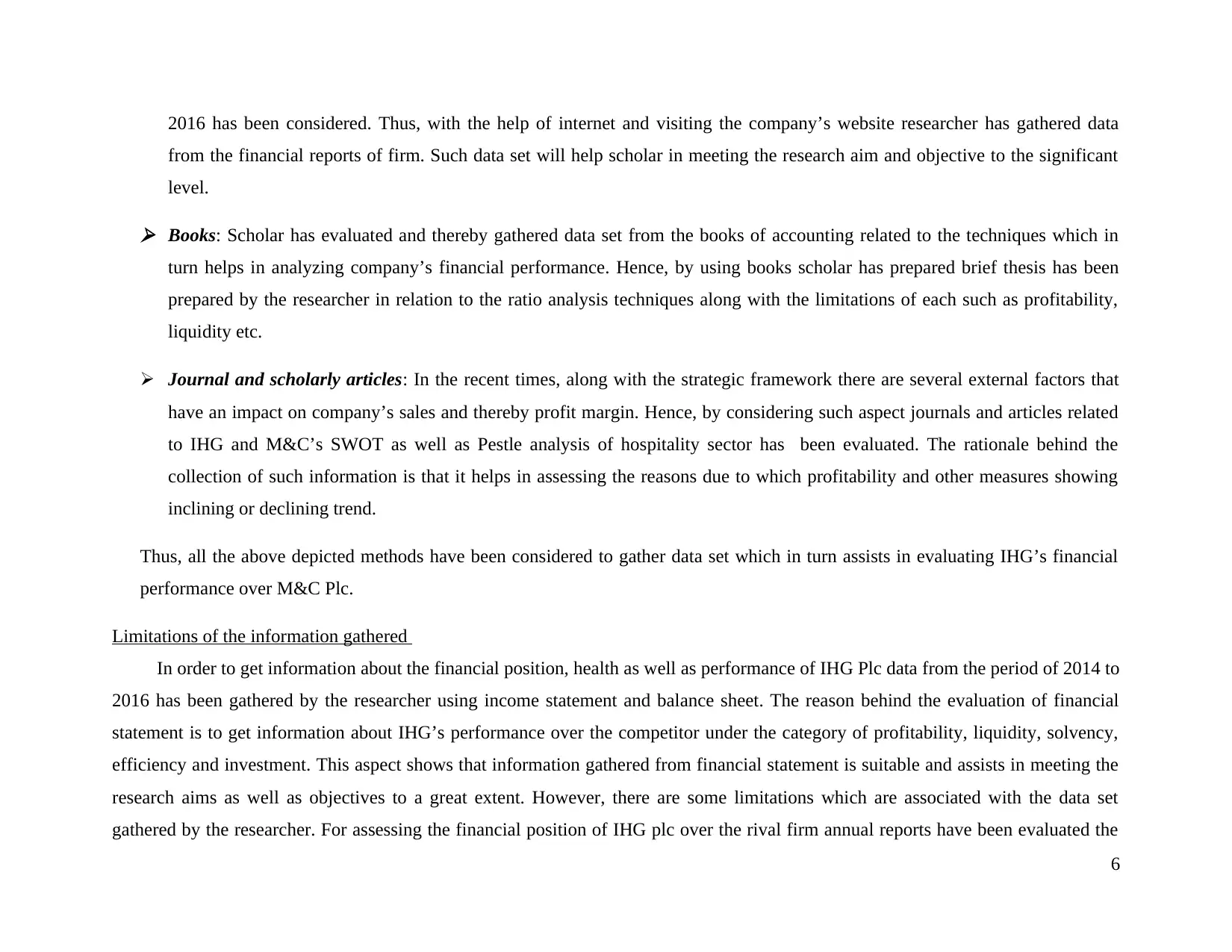
2016 has been considered. Thus, with the help of internet and visiting the company’s website researcher has gathered data
from the financial reports of firm. Such data set will help scholar in meeting the research aim and objective to the significant
level.
Books: Scholar has evaluated and thereby gathered data set from the books of accounting related to the techniques which in
turn helps in analyzing company’s financial performance. Hence, by using books scholar has prepared brief thesis has been
prepared by the researcher in relation to the ratio analysis techniques along with the limitations of each such as profitability,
liquidity etc.
Journal and scholarly articles: In the recent times, along with the strategic framework there are several external factors that
have an impact on company’s sales and thereby profit margin. Hence, by considering such aspect journals and articles related
to IHG and M&C’s SWOT as well as Pestle analysis of hospitality sector has been evaluated. The rationale behind the
collection of such information is that it helps in assessing the reasons due to which profitability and other measures showing
inclining or declining trend.
Thus, all the above depicted methods have been considered to gather data set which in turn assists in evaluating IHG’s financial
performance over M&C Plc.
Limitations of the information gathered
In order to get information about the financial position, health as well as performance of IHG Plc data from the period of 2014 to
2016 has been gathered by the researcher using income statement and balance sheet. The reason behind the evaluation of financial
statement is to get information about IHG’s performance over the competitor under the category of profitability, liquidity, solvency,
efficiency and investment. This aspect shows that information gathered from financial statement is suitable and assists in meeting the
research aims as well as objectives to a great extent. However, there are some limitations which are associated with the data set
gathered by the researcher. For assessing the financial position of IHG plc over the rival firm annual reports have been evaluated the
6
from the financial reports of firm. Such data set will help scholar in meeting the research aim and objective to the significant
level.
Books: Scholar has evaluated and thereby gathered data set from the books of accounting related to the techniques which in
turn helps in analyzing company’s financial performance. Hence, by using books scholar has prepared brief thesis has been
prepared by the researcher in relation to the ratio analysis techniques along with the limitations of each such as profitability,
liquidity etc.
Journal and scholarly articles: In the recent times, along with the strategic framework there are several external factors that
have an impact on company’s sales and thereby profit margin. Hence, by considering such aspect journals and articles related
to IHG and M&C’s SWOT as well as Pestle analysis of hospitality sector has been evaluated. The rationale behind the
collection of such information is that it helps in assessing the reasons due to which profitability and other measures showing
inclining or declining trend.
Thus, all the above depicted methods have been considered to gather data set which in turn assists in evaluating IHG’s financial
performance over M&C Plc.
Limitations of the information gathered
In order to get information about the financial position, health as well as performance of IHG Plc data from the period of 2014 to
2016 has been gathered by the researcher using income statement and balance sheet. The reason behind the evaluation of financial
statement is to get information about IHG’s performance over the competitor under the category of profitability, liquidity, solvency,
efficiency and investment. This aspect shows that information gathered from financial statement is suitable and assists in meeting the
research aims as well as objectives to a great extent. However, there are some limitations which are associated with the data set
gathered by the researcher. For assessing the financial position of IHG plc over the rival firm annual reports have been evaluated the
6
⊘ This is a preview!⊘
Do you want full access?
Subscribe today to unlock all pages.

Trusted by 1+ million students worldwide
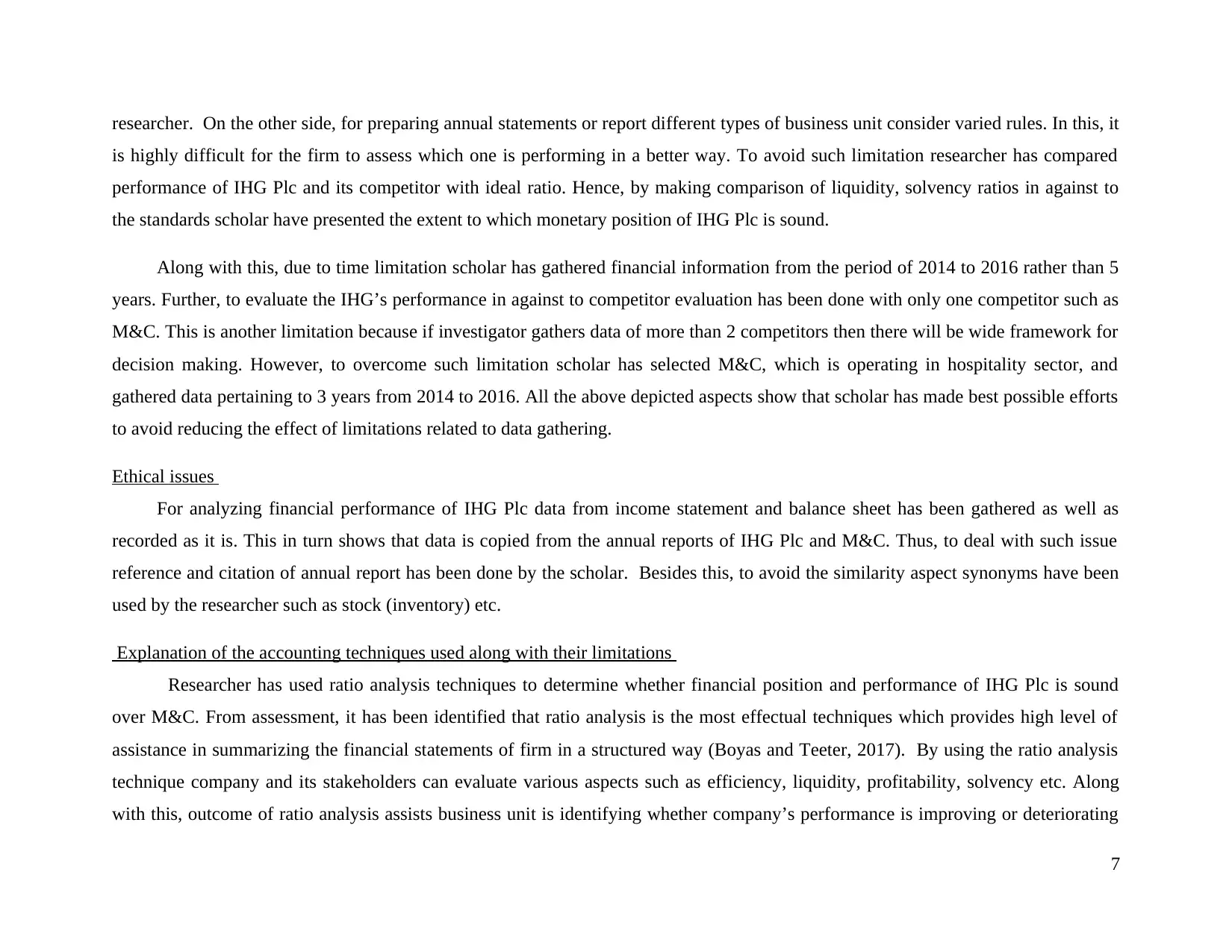
researcher. On the other side, for preparing annual statements or report different types of business unit consider varied rules. In this, it
is highly difficult for the firm to assess which one is performing in a better way. To avoid such limitation researcher has compared
performance of IHG Plc and its competitor with ideal ratio. Hence, by making comparison of liquidity, solvency ratios in against to
the standards scholar have presented the extent to which monetary position of IHG Plc is sound.
Along with this, due to time limitation scholar has gathered financial information from the period of 2014 to 2016 rather than 5
years. Further, to evaluate the IHG’s performance in against to competitor evaluation has been done with only one competitor such as
M&C. This is another limitation because if investigator gathers data of more than 2 competitors then there will be wide framework for
decision making. However, to overcome such limitation scholar has selected M&C, which is operating in hospitality sector, and
gathered data pertaining to 3 years from 2014 to 2016. All the above depicted aspects show that scholar has made best possible efforts
to avoid reducing the effect of limitations related to data gathering.
Ethical issues
For analyzing financial performance of IHG Plc data from income statement and balance sheet has been gathered as well as
recorded as it is. This in turn shows that data is copied from the annual reports of IHG Plc and M&C. Thus, to deal with such issue
reference and citation of annual report has been done by the scholar. Besides this, to avoid the similarity aspect synonyms have been
used by the researcher such as stock (inventory) etc.
Explanation of the accounting techniques used along with their limitations
Researcher has used ratio analysis techniques to determine whether financial position and performance of IHG Plc is sound
over M&C. From assessment, it has been identified that ratio analysis is the most effectual techniques which provides high level of
assistance in summarizing the financial statements of firm in a structured way (Boyas and Teeter, 2017). By using the ratio analysis
technique company and its stakeholders can evaluate various aspects such as efficiency, liquidity, profitability, solvency etc. Along
with this, outcome of ratio analysis assists business unit is identifying whether company’s performance is improving or deteriorating
7
is highly difficult for the firm to assess which one is performing in a better way. To avoid such limitation researcher has compared
performance of IHG Plc and its competitor with ideal ratio. Hence, by making comparison of liquidity, solvency ratios in against to
the standards scholar have presented the extent to which monetary position of IHG Plc is sound.
Along with this, due to time limitation scholar has gathered financial information from the period of 2014 to 2016 rather than 5
years. Further, to evaluate the IHG’s performance in against to competitor evaluation has been done with only one competitor such as
M&C. This is another limitation because if investigator gathers data of more than 2 competitors then there will be wide framework for
decision making. However, to overcome such limitation scholar has selected M&C, which is operating in hospitality sector, and
gathered data pertaining to 3 years from 2014 to 2016. All the above depicted aspects show that scholar has made best possible efforts
to avoid reducing the effect of limitations related to data gathering.
Ethical issues
For analyzing financial performance of IHG Plc data from income statement and balance sheet has been gathered as well as
recorded as it is. This in turn shows that data is copied from the annual reports of IHG Plc and M&C. Thus, to deal with such issue
reference and citation of annual report has been done by the scholar. Besides this, to avoid the similarity aspect synonyms have been
used by the researcher such as stock (inventory) etc.
Explanation of the accounting techniques used along with their limitations
Researcher has used ratio analysis techniques to determine whether financial position and performance of IHG Plc is sound
over M&C. From assessment, it has been identified that ratio analysis is the most effectual techniques which provides high level of
assistance in summarizing the financial statements of firm in a structured way (Boyas and Teeter, 2017). By using the ratio analysis
technique company and its stakeholders can evaluate various aspects such as efficiency, liquidity, profitability, solvency etc. Along
with this, outcome of ratio analysis assists business unit is identifying whether company’s performance is improving or deteriorating
7
Paraphrase This Document
Need a fresh take? Get an instant paraphrase of this document with our AI Paraphraser
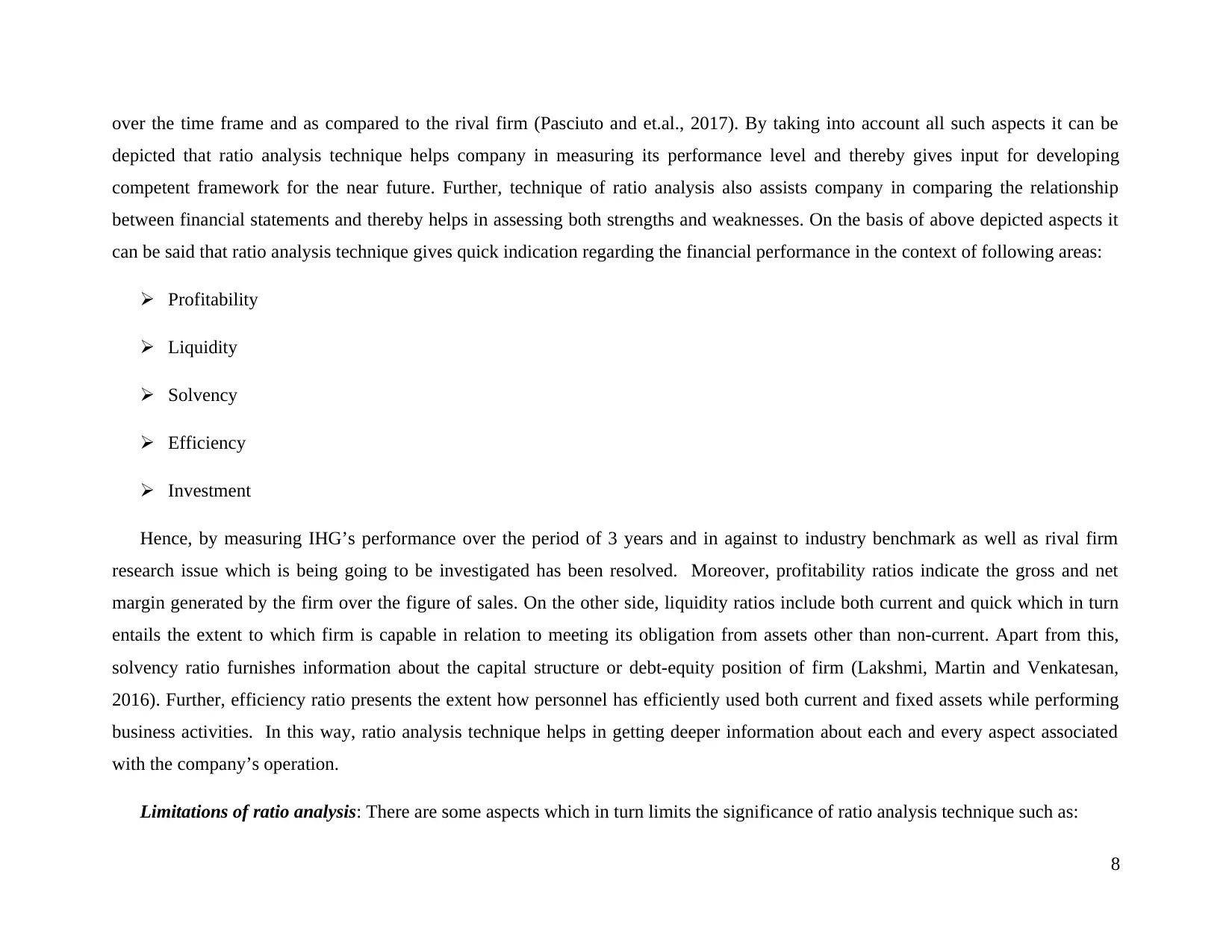
over the time frame and as compared to the rival firm (Pasciuto and et.al., 2017). By taking into account all such aspects it can be
depicted that ratio analysis technique helps company in measuring its performance level and thereby gives input for developing
competent framework for the near future. Further, technique of ratio analysis also assists company in comparing the relationship
between financial statements and thereby helps in assessing both strengths and weaknesses. On the basis of above depicted aspects it
can be said that ratio analysis technique gives quick indication regarding the financial performance in the context of following areas:
Profitability
Liquidity
Solvency
Efficiency
Investment
Hence, by measuring IHG’s performance over the period of 3 years and in against to industry benchmark as well as rival firm
research issue which is being going to be investigated has been resolved. Moreover, profitability ratios indicate the gross and net
margin generated by the firm over the figure of sales. On the other side, liquidity ratios include both current and quick which in turn
entails the extent to which firm is capable in relation to meeting its obligation from assets other than non-current. Apart from this,
solvency ratio furnishes information about the capital structure or debt-equity position of firm (Lakshmi, Martin and Venkatesan,
2016). Further, efficiency ratio presents the extent how personnel has efficiently used both current and fixed assets while performing
business activities. In this way, ratio analysis technique helps in getting deeper information about each and every aspect associated
with the company’s operation.
Limitations of ratio analysis: There are some aspects which in turn limits the significance of ratio analysis technique such as:
8
depicted that ratio analysis technique helps company in measuring its performance level and thereby gives input for developing
competent framework for the near future. Further, technique of ratio analysis also assists company in comparing the relationship
between financial statements and thereby helps in assessing both strengths and weaknesses. On the basis of above depicted aspects it
can be said that ratio analysis technique gives quick indication regarding the financial performance in the context of following areas:
Profitability
Liquidity
Solvency
Efficiency
Investment
Hence, by measuring IHG’s performance over the period of 3 years and in against to industry benchmark as well as rival firm
research issue which is being going to be investigated has been resolved. Moreover, profitability ratios indicate the gross and net
margin generated by the firm over the figure of sales. On the other side, liquidity ratios include both current and quick which in turn
entails the extent to which firm is capable in relation to meeting its obligation from assets other than non-current. Apart from this,
solvency ratio furnishes information about the capital structure or debt-equity position of firm (Lakshmi, Martin and Venkatesan,
2016). Further, efficiency ratio presents the extent how personnel has efficiently used both current and fixed assets while performing
business activities. In this way, ratio analysis technique helps in getting deeper information about each and every aspect associated
with the company’s operation.
Limitations of ratio analysis: There are some aspects which in turn limits the significance of ratio analysis technique such as:
8
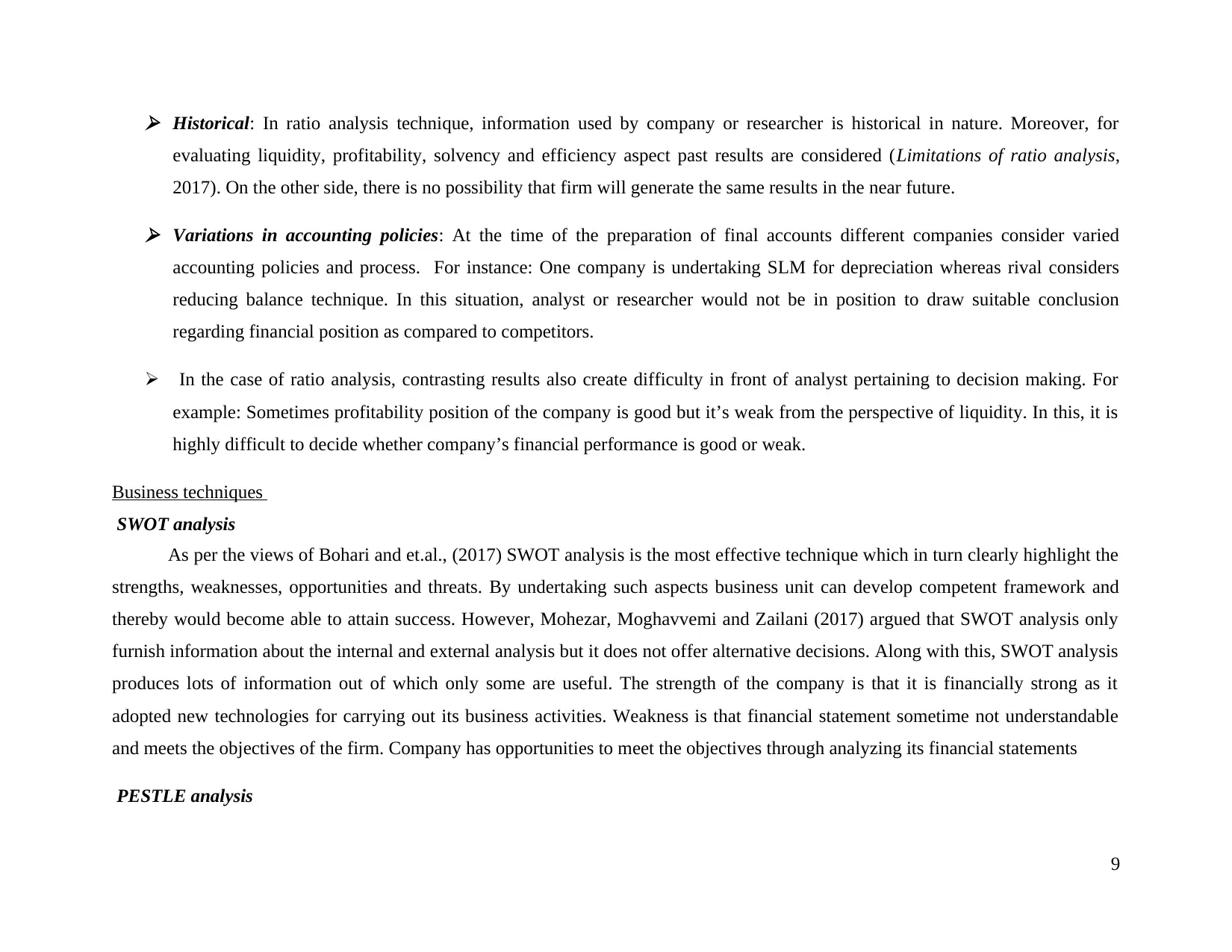
Historical: In ratio analysis technique, information used by company or researcher is historical in nature. Moreover, for
evaluating liquidity, profitability, solvency and efficiency aspect past results are considered (Limitations of ratio analysis,
2017). On the other side, there is no possibility that firm will generate the same results in the near future. Variations in accounting policies: At the time of the preparation of final accounts different companies consider varied
accounting policies and process. For instance: One company is undertaking SLM for depreciation whereas rival considers
reducing balance technique. In this situation, analyst or researcher would not be in position to draw suitable conclusion
regarding financial position as compared to competitors.
In the case of ratio analysis, contrasting results also create difficulty in front of analyst pertaining to decision making. For
example: Sometimes profitability position of the company is good but it’s weak from the perspective of liquidity. In this, it is
highly difficult to decide whether company’s financial performance is good or weak.
Business techniques
SWOT analysis
As per the views of Bohari and et.al., (2017) SWOT analysis is the most effective technique which in turn clearly highlight the
strengths, weaknesses, opportunities and threats. By undertaking such aspects business unit can develop competent framework and
thereby would become able to attain success. However, Mohezar, Moghavvemi and Zailani (2017) argued that SWOT analysis only
furnish information about the internal and external analysis but it does not offer alternative decisions. Along with this, SWOT analysis
produces lots of information out of which only some are useful. The strength of the company is that it is financially strong as it
adopted new technologies for carrying out its business activities. Weakness is that financial statement sometime not understandable
and meets the objectives of the firm. Company has opportunities to meet the objectives through analyzing its financial statements
PESTLE analysis
9
evaluating liquidity, profitability, solvency and efficiency aspect past results are considered (Limitations of ratio analysis,
2017). On the other side, there is no possibility that firm will generate the same results in the near future. Variations in accounting policies: At the time of the preparation of final accounts different companies consider varied
accounting policies and process. For instance: One company is undertaking SLM for depreciation whereas rival considers
reducing balance technique. In this situation, analyst or researcher would not be in position to draw suitable conclusion
regarding financial position as compared to competitors.
In the case of ratio analysis, contrasting results also create difficulty in front of analyst pertaining to decision making. For
example: Sometimes profitability position of the company is good but it’s weak from the perspective of liquidity. In this, it is
highly difficult to decide whether company’s financial performance is good or weak.
Business techniques
SWOT analysis
As per the views of Bohari and et.al., (2017) SWOT analysis is the most effective technique which in turn clearly highlight the
strengths, weaknesses, opportunities and threats. By undertaking such aspects business unit can develop competent framework and
thereby would become able to attain success. However, Mohezar, Moghavvemi and Zailani (2017) argued that SWOT analysis only
furnish information about the internal and external analysis but it does not offer alternative decisions. Along with this, SWOT analysis
produces lots of information out of which only some are useful. The strength of the company is that it is financially strong as it
adopted new technologies for carrying out its business activities. Weakness is that financial statement sometime not understandable
and meets the objectives of the firm. Company has opportunities to meet the objectives through analyzing its financial statements
PESTLE analysis
9
⊘ This is a preview!⊘
Do you want full access?
Subscribe today to unlock all pages.

Trusted by 1+ million students worldwide
1 out of 51
Related Documents
Your All-in-One AI-Powered Toolkit for Academic Success.
+13062052269
info@desklib.com
Available 24*7 on WhatsApp / Email
![[object Object]](/_next/static/media/star-bottom.7253800d.svg)
Unlock your academic potential
Copyright © 2020–2025 A2Z Services. All Rights Reserved. Developed and managed by ZUCOL.





